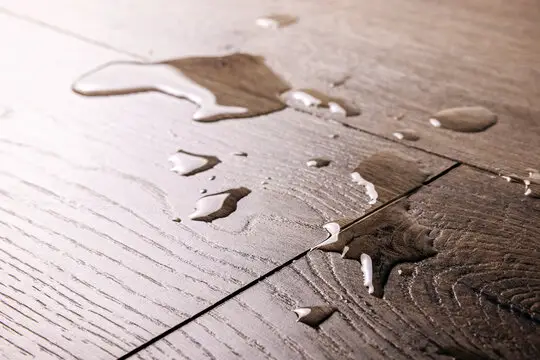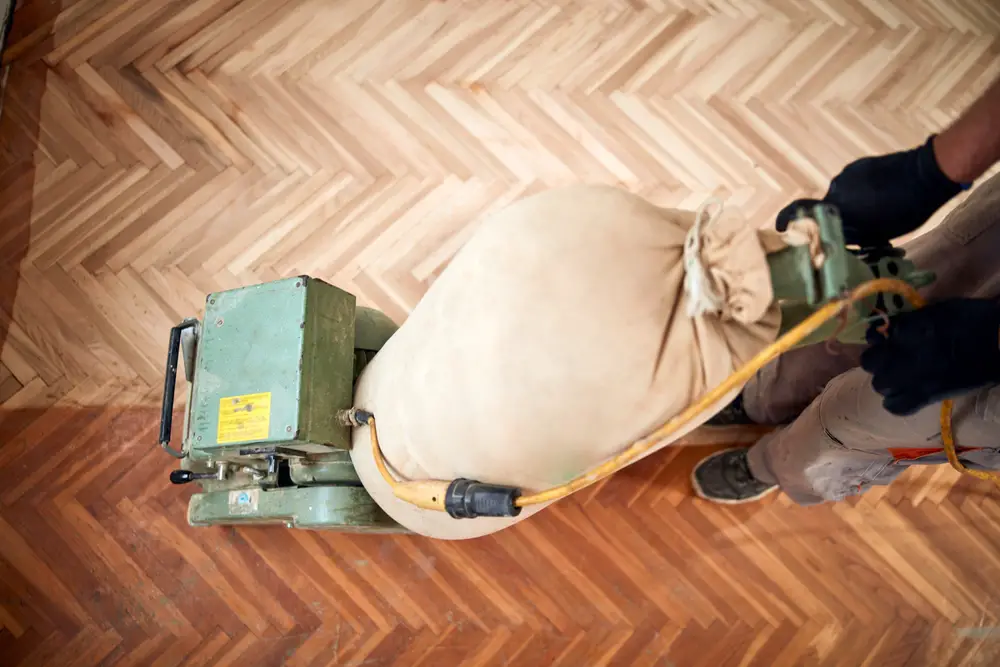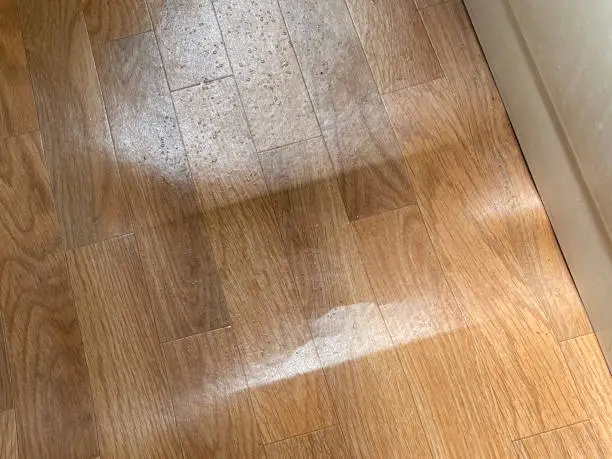Swollen laminate flooring often occurs due to water damage and tends to disrupt the aesthetic appeal of your space. However, before you contemplate a complete replacement, it’s important to know that you can repair swollen laminate flooring without replacing it.
This guide aims to provide you with practical and effective steps to restore your flooring to its original state, ensuring its longevity and maintaining your home’s beauty.
Swollen laminate flooring is a common issue, primarily caused by prolonged exposure to moisture or water. This problem manifests as an unsightly bulge or lift in the laminate flooring, disrupting the smooth surface and aesthetic continuity of your floor.
If left unchecked, this swelling can spread to neighboring boards, exacerbating the issue and potentially causing structural damage. The swelling can also make the floor uneven, posing a tripping hazard.
This issue is particularly prevalent in areas with high humidity or in rooms where water spillage is common, such as kitchens and bathrooms. The good news is, it’s possible to rectify this situation without resorting to a total floor replacement.
Understanding the Causes
How Laminate Flooring Swells
Laminate flooring swells when it absorbs moisture. The core of most laminate floors is made from high-density fiberboard (HDF), a material that’s highly susceptible to water damage.
When the laminate’s protective top layer is compromised, whether by scratches, cracks, or poorly sealed edges, water can seep into the HDF. As the HDF absorbs the moisture, it expands, causing the laminate flooring to bulge or swell.
This swelling can be localized to the area directly exposed to moisture or can spread to other parts of the floor if the water seeps further into the laminate.
Water Damage
Water damage is one of the most prevalent causes of laminate flooring swelling. This occurs when water or any other liquid spills onto the floor and is not promptly wiped away, giving it enough time to seep through the cracks and crevices of the laminate floor.
This problem is more pronounced in areas of high foot traffic where spills are more likely to occur or go unnoticed.
The moisture absorbed by the laminate material leads to its expansion, resulting in the visible swelling of the floor.
It’s also important to note that water damage can occur due to leaks that are unseen or hidden. These leaks can be from pipes or appliances, and if undetected, can cause severe water damage to laminate flooring over time.
High Humidity
Humidity also plays a significant role in causing laminate flooring to swell. High levels of humidity in the environment can lead to an increased amount of moisture in the air.
This moisture can be absorbed by the laminate flooring, causing it to swell, even without direct water contact. Areas with naturally high humidity levels or rooms like kitchens and bathrooms, where steam and moisture are common, are particularly at risk.
Inadequate or improper installation of the laminate flooring can also exacerbate the effects of humidity.
If there isn’t enough space left for expansion during installation, the laminate can push against itself when it expands due to high humidity, leading to swelling.
Preventing these common causes requires appropriate measures like timely cleanup of spills, regular checks for leaks, and maintaining a suitable indoor humidity level.
Proper installation of the laminate flooring, leaving enough room for natural expansion, can also significantly help prevent the floor from swelling.
Preparatory Steps
Safety Precautions
Before attempting any repair or maintenance on your laminate flooring, it’s crucial to follow certain safety precautions to protect yourself and the flooring. Always wear appropriate protective gear, including gloves and safety glasses, particularly when working with any chemicals or sharp tools.
If you’re dealing with water-damaged areas, turn off any nearby electronics to avoid electrical hazards. Be mindful of your surroundings to prevent any accidental slips or falls, especially in wet areas.
It’s also important to use any cleaning products or chemicals according to their instructions to avoid damage to the flooring or potential health risks. A well-ventilated area is desirable when dealing with strong fumes from adhesives or cleaners.
Lastly, if the task seems beyond your skill level, don’t hesitate to seek professional assistance to avoid inadvertently causing more damage.
Gathering Necessary Tools and Materials
Before embarking on your laminate floor repair task, it’s crucial to have all the necessary tools and materials at hand. These may vary depending on the specific issues you’re addressing, but the following is a general list to consider:
Laminate Flooring Repair Kit: These kits typically include colored wax, a putty knife, and other tools specifically designed for laminate floor repairs.
Replacement Laminate Planks: If your floor has severe damage, it might be necessary to replace entire planks. Make sure to have matching ones to maintain a uniform look.
PVA Wood Glue: This type of glue is often used for minor repairs like fixing chips or small cracks.
Soft Cloth or Sponge: Needed for cleaning the area and wiping off excess glue.
Safety Gear: Protective gloves, safety glasses, and possibly a mask if you’ll be working with harsh chemicals.
Putty Knife and Chisel: These can help to remove damaged planks without affecting the surrounding area.
Tape Measure and Carpenter’s Square: For accurate measurements when cutting replacement planks.
Rubber Mallet: Useful for fitting replacement planks into place without causing damage.
Sealant: A waterproof sealant can be applied to the edges of the flooring to prevent future water damage.
Draining the Excess Water

Before you can start draining the excess water, you need to identify its source. Swollen laminate flooring is usually a consequence of water seepage or spills that have not been promptly cleaned up.
Start by inspecting the swollen area and the surroundings. Look for any liquid or dampness. If the swelling is near a sink, dishwasher, or any other water source, leakage is likely causing the issue. If you cannot find the water source, consider reaching out to a professional.
Once the water source is identified, it’s time to drain the excess water. Start by blotting up visible water using an absorbent towel. Be gentle to avoid inflicting further damage to the swollen laminate flooring.
Do not rub or scrub as this might spread the water to unaffected areas.
To address water that has seeped into the laminate flooring, a wet vacuum can be exceptionally effective. It is designed to suck up water, making it perfect for this task. Move the vacuum across the swollen area and the surrounding flooring to ensure all hidden moisture is sucked up.
Another method to help drain water from your swollen laminate flooring is to use a dehumidifier. Place the dehumidifier in the room with the affected area and let it run for at least 24 hours.
This machine works by extracting moisture from the air and the floor, speeding up the drying process.
Drying the Area

Properly drying the area affected by water damage is crucial to restore the laminate flooring and prevent the growth of mold and mildew. One effective method is to use fans and heaters. Direct a fan or a space heater towards the affected area to promote evaporation and speed up the drying process.
Remember to not use the heater for an extended period as it may dry out the laminate excessively, causing it to crack.
For areas that are difficult to reach, consider using a hairdryer in a low-heat setting. It can provide a more focused airflow, but be sure to move it around often to prevent overheating and further damage to your laminate.
In cases where the laminate flooring is extremely swollen or the water has permeated to the subfloor, it may be necessary to remove the affected laminate planks to dry the underlying area.
Use a pry bar to carefully lift the swollen laminate planks, then use fans or dehumidifiers to dry the subfloor thoroughly.
Another technique is to use desiccant materials, such as silica gel or calcium chloride, to absorb residual moisture. Place these desiccants in a container and keep them near the damp area.
They work by absorbing moisture from the air, thus reducing the room’s overall humidity and aiding in the drying process.
Remember, the key to effectively drying your swollen laminate flooring and the underlying area is time and patience. The drying process can take several days to weeks, depending on the severity of the water damage.
Always ensure the area is completely dry before proceeding with repairs to prevent further issues.
Sanding and Cleaning the Swollen Area

Sanding the Swollen Area
Preparation: Before you start sanding, ensure you’re wearing the right safety gear. This includes a dust mask, safety goggles, and work gloves. These are essential to protect you from dust and rough edges of the laminate.
Select your Sandpaper: Choose a medium-grit sandpaper (about 120 to 150 grit) for the initial sanding. This will help to level the swollen area effectively without causing additional damage.
Sanding Process: Begin sanding the swollen area with light and even strokes. Make sure to sand in the direction of the grain to avoid scratching the surface. Apply even pressure throughout to ensure a consistent finish.
Fine-tuning: After the initial sanding, switch to fine-grit sandpaper (about 180 to 220 grit) to smooth out any rough patches. This step gives your laminate a smooth finish, preparing it for the cleaning process.
Cleaning the Sanded Area
Dust removal: After sanding, there will be dust and debris on the laminate surface. Use a soft brush or a vacuum cleaner to remove these particles. Ensure you reach into every nook and cranny to remove all remnants of dust.
Washing: Mix a few drops of mild dish soap with warm water. Dampen a soft cloth or sponge in the solution and gently clean the sanded area. Avoid soaking the laminate; a damp cloth will suffice.
Rinsing: Rinse the cleaned area with a damp cloth dipped in clean water. This will help to remove any soap residue left on the laminate surface.
Drying: Dry the area thoroughly using a clean, dry towel. It’s essential to ensure that no moisture is left on the laminate surface as this can lead to further swelling.
Polishing: Once the laminate is dry, consider using a laminate floor polish to restore shine. Follow the manufacturer’s instructions when applying the polish.
Related Topics:
Sealing the Laminate Flooring
After the cleaning and polishing process, it’s crucial to seal your laminate flooring to prevent future swelling. Here are the detailed steps for sealing your laminate flooring:
Choose the Right Sealer: Opt for a sealer that is specifically designed for laminate flooring. These sealers often contain waterproof properties that help to safeguard the surface against moisture, thus preventing future swelling.
Applying the Sealer: Start from one corner of the room and work your way across the floor, following the grain of the laminate.
It’s usually best to apply the sealer in thin, even coats using a foam roller or brush. Ensure that the application is smooth and even, without leaving any puddles of sealer.
Drying Time: Allow the sealer to dry as per the manufacturer’s instructions. The drying time can vary from product to product, but typically it can take between 2-4 hours for the sealer to dry completely.
Avoid walking on the floor during this period.
Second Coat Application: Apply a second coat of sealer after the first one has fully dried. This will ensure comprehensive coverage and optimal protection. Make sure to apply it in the same direction as the first coat.
Final Drying: Once the second coat is applied, let the floor dry thoroughly. It is recommended to wait 24 hours before resuming normal traffic on the floor.
This gives the sealer enough time to cure and provide a robust protective layer.
Conclusion
Repairing swollen laminate flooring without resorting to a complete replacement can save you significant time and money.
By understanding the causes and signs of swelling, taking appropriate precautions, gathering the right tools, and following the steps outlined in this guide, you can effectively restore your laminate floor to its original condition.
Although the process may seem laborious, it is ultimately rewarding as it prolongs the lifespan of your laminate flooring and maintains the aesthetic appeal of your space.
If the swelling persists or recurs frequently, it may be a sign of a larger underlying issue that might require professional attention. Remember, prevention is always better than cure; hence, regular maintenance and quick action against spills can help prevent such issues in the first place.
FAQs
What are the common causes of swollen laminate flooring?
Swollen laminate flooring usually occurs due to exposure to moisture or high humidity. This can happen when liquid spills aren’t promptly cleaned up or in areas of high humidity such as bathrooms and kitchens. Improper installation or poor-quality laminate can also lead to swelling.
Can swollen laminate flooring be repaired without replacing the entire floor?
Yes, in many cases, swollen laminate flooring can be repaired without the need to replace the entire floor. This involves steps like identifying the affected planks, carefully removing them, drying out the area, and applying a good quality sealer. However, in cases of extensive damage or frequent recurrence of swelling, it might be necessary to seek professional help or consider a full replacement.

1 thought on “How To Repair Swollen Laminate Flooring Without Replacing”